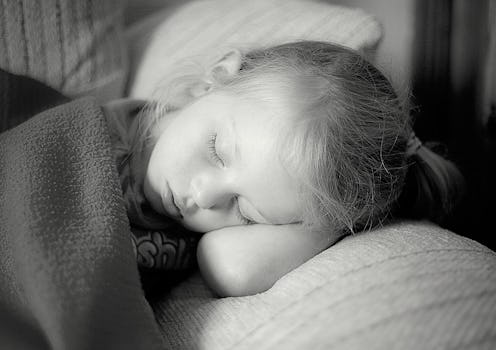Life
Watch This Little Girl Play Piano In Her Sleep

A video posted to YouTube yesterday shows a young girl playing piano in her sleep. The poster, from New Zealand, writes, “This is my cousins daughter, she sleepwalks every now and then. But on this occasion played the Piano... she really is fast asleep.” The video depicts the sleeping girl tapping out simple melodies on the piano keys, even as she leans her head against the top of the piano and lets out an occasional snore. It’s a strange sight, to be sure, but the weirdest thing about the incident is that, compared to many of the other things people do while sleepwalking, piano-playing is actually fairly tame.
According to the National Sleep Foundation, between 1 and 15 percent of the population sleepwalks. Sleepwalking, or somnambulism, is a sleep disorder that begins in deep sleep and involves sleeping people performing complex actions, from simple walking to more complex activities like cooking. Although people of any age can sleepwalk, the behavior is more prevalent in children than adults. The man who posted the video of the sleeping piano player writes that, following the late-night jam session, the girl, “could not remember doing this”; this inability to remember is typical of sleepwalking in general.
Many of us who have encountered people sleepwalking before are aware that it can be really creepy. My own little sister used to freak me out when we were kids by sitting up in bed and having long, rambling conversations with herself. There’s a common myth that one shouldn’t wake sleepwalkers, but the National Sleep Foundation reports that waking them is not dangerous (they might be disoriented by waking suddenly from deep sleep, but it won’t hurt them), and that, in fact, it could be dangerous not to wake them. While some sleepwalking behaviors are completely harmless — like playing the piano — others are potentially hazardous, like walking outside of one’s home or driving a car.
Watch the full piano-playing incident below (Is it bad that this girl plays the piano better in her sleep than I do on my very best day?), and then keep reading for five other bizarre behaviors you can perform in your sleep:
1. Talking
Sleep talking is a fairly common sleep behavior, exhibited by children and men more often than women. Some sleep talkers only mumble incoherently in their sleep, while others are able to speak clearly and have whole conversations. Even if someone’s sleeping statements are coherent, they aren’t products of a conscious brain, so one shouldn’t take them as truth (and, in fact, they aren’t allowed to be submitted as evidence in court).
As with sleep walking, sleep talking is exacerbated by stress, inadequate sleep, alcohol, and caffeine, so if you’re keeping people up at night with your chatter or roaming about the house, be sure to get some rest, avoid alcohol, and moderate your coffee intake.
2. Eating
Sleepeating is a sleep disorder characterized by (no surprise) eating while asleep. According to the American Sleep Association, sleepeating often involves eating to excess, eating particularly unhealthy food, and eating food in ways that usually wouldn’t occur while waking (such as eating sugar or syrup all on their own). Unlike sleepwalkers, sleep eaters don’t usually go on to perform other activities; however, their sleep eating is consistent, usually occurring at least once every night. Sleepeating can be dangerous when people attempt to cook or eat things that aren’t actually food.
3. Having Sex
“Sexsomnia” is a rare sleep disorder characterized by people trying to perform, or actually performing, sexual activities while asleep. These behaviors may range from masturbation to intercourse with a partner. As with sleepwalking, people with sexsomnia usually will not remember their actions upon waking. This disorder has even been used as a defense against charges of rape; Last year, for example, a man in Sweden had a rape conviction overturned when it was proven that he suffered from sexsomnia.
4. Driving
Apparently, there have been quite a few cases of people getting up in their sleep, grabbing their keys, and hitting the road. In 2012, for example, a U.K. woman, Becky Mason, was acquitted of drunk driving after she crashed her car with three times the legal limit of alcohol in her system, on the grounds that she had been asleep while doing it. Mason had no memory of her actions prior to the event, but evidence and testimony from a witness suggested that at some point in the evening, she had fallen asleep, drunk a bottle of wine, gotten in her car, and driven to work. A security guard was surprised to see her show up to work in her pajamas on a Saturday night; eventually she got back into her car — still asleep — and hit a lamp post.
5. Murder
In 2003, a man in Manchester, Jules Lowe, attacked and killed his elderly father. Two years later, he was acquitted of the charge of murder due to the fact that he had been asleep throughout the attack. Dr. Irshaad Ebrahim, a sleep expert called in to assess the case, told the BBC that the Lowe case was the first sleepwalking murder in the U.K., of about 68 worldwide. Others accused of murder have attempted to use the sleepwalking defense, but most don’t succeed. Dr. Ebrahim explained, “[E]xtreme forms of violence, of sleepwalking or automatism, are extremely rare, so we usually view them with a high index of suspicion.”